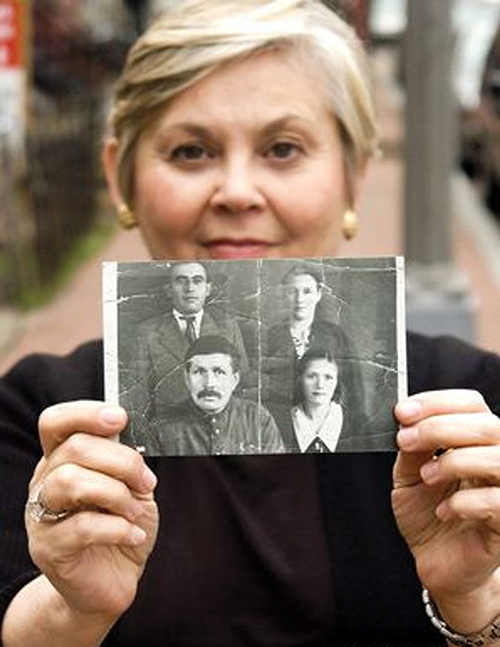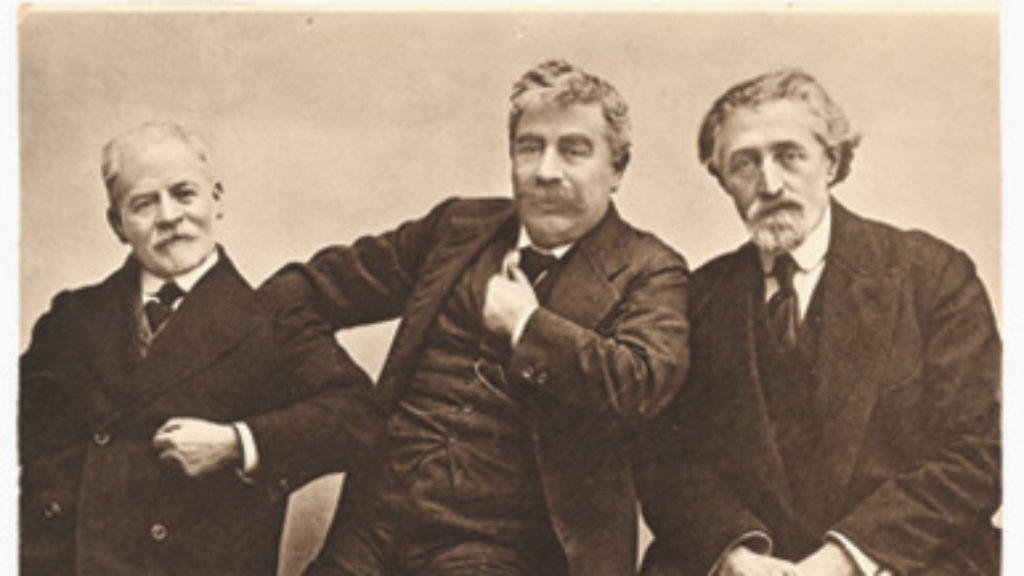At Home in America
In a strikingly beautiful passage in Jonathan Safran Foer’s novel Everything Is Illuminated,the narrator sees his grandmother eagerly calling for her daughter, now in her early twenties, to watch the television screen as America lands a man on the moon.
My grandmother struggles to her feet—old, even then—and says, with many different kinds of tears in her eyes, Etz vunderful! She kisses my mother, hides her hands in my mother’s hair, and says, Etz vunderful! . . . My mother is also crying, each tear unique. They cry together, cheek to cheek. And neither of them hears the astronaut whisper, I see something, while gazing over the lunar horizon at the tiny village of Trachimbrod. There’s definitely something out there.
What’s really out there is the dilemma at the heart of Foer’s tale, in which the protagonist, a hapless, shortish, phobic college student with Foer’s name, searches for but never locates his family’s native Trachimbrod on the craggy, pockmarked western edge of post-Soviet Ukraine. What he’d find there if unearthed, perhaps fortunately for him, is something he never needs to face. The novel was inspired by Foer’s undergraduate Princeton thesis, which was his mother’s idea, and it is the prospect of filling out this story—of finally finding Trachimbrod—that is the inspiration for her new memoir.

Esther Safran Foer’s book is an effort, as she explains, to complete a family history filled with ghosts—her Holocaust-survivor father, who committed suicide when she was eight; his own prewar family, who were never discussed; her mother’s younger sister, who disappeared during the war. Whatever joy she has felt over the course of her life “is tempered,” Foer writes, “by shadows of the past.”
One doesn’t doubt it. But, then again, this memoir-cum-genealogy is chock-full of indefatigably American nachas—a happy and prosperous marriage; a job as an influential Washington, DC, cultural impresario; no fewer than three sons with literary resumes rivaling that of Isaac Bashevis Singer and his remarkable siblings; even a family appearance on the Martha Stewart show. Amid all this joy, the shadows that haunt this memoir feel insubstantial, immeasurably less pertinent than the daily life that Esther Safran Foer so clearly relishes. Just beneath the surface of this Holocaust memoir is, in fact, an altogether different tale: a paean to the good life in America.
Foer tells how, in middle age, she started to feel a particular urgency to fill out the silences, the sporadic “foundational stories” she heard over the years about her family’s prewar and wartime past. She knew next to nothing about her father’s first wife and children, who were killed in the war—only a cluster of disjointed details about their hometowns—or, for that matter, how her parents managed to survive before meeting at the war’s end. A wartime photograph of her father with the non-Jewish family that hid him, at least for a time, provides a clue: the word “Augustine” or something like it—a name or an address—is scrawled on the back. She writes:
I set out to find the family that had hidden my father during the war and to see what I could learn about the sibling I had never known. I set out to find a shtetl that, by all accounts, was no more. . . . I set out to let my ancestors know that I haven’t forgotten them. That we are still here.
To close these gaps, Foer traveled to Brazil and Israel, underwent DNA testing, hobnobbed with a former US ambassador to Senegal, consulted the late National Security Advisor Sandy Berger, and hired a former FBI agent. She is a meticulous and practical genealogist dispensing clearheaded advice regarding the value of plastic bags and the best way to find local maps. And throughout, she boasts of the achievements of her remarkable offspring; the success of Everything Is Illuminated is mentioned no fewer than seven times. Sitting in the sparsely furnished living room in Trachimbrod with relatives of the man who saved her father, she felt the need to describe how the movie version of her son’s novelfeatured the star of the film The Lord of the Rings, but “I didn’t even get much of a rise.”
She managed to complete her mission, piecing together a family saga with its share of surprises: divorce and remarriage, as well as prewar non-Jewish neighbors so friendly that some commanded a passable Yiddish. She ferreted out the name and hair color of her half-sister and the birthplace of her mother. “I suppose,” she muses, “it should not have been surprising that life was complicated, even back then.”
Along the way, Foer shows persistence and ingenuity, coupled with a fair bit of luck. Hence, this saga, too, is told as a success story, the memoir of a woman confident and determined with only the sparsest of self-revelatory moments. The most revealing of these feel quite accidental—for instance, her passing acknowledgment that the urgency of her quest had rather less to do with a preoccupation with the dark past than with just the opposite:
I had engaged in stimulating and exciting work in politics and public affairs for many years. It’s just that what I was doing did not have much relationship to my central concerns or with these places back in Ukraine that haunted me.
Thus, it seems what most “haunts” her—a term repeatedly used—is not the Jewish past so much as the unsettling reality that this past intrudes so little on an ever-vital present. It is its absence that most disturbs—the simple fact that, although she was born in a European DP camp to a family of survivors, the past doesn’t bear down very heavily on Foer’s everyday life. And it was at just the moment when all seemed to have worked out so well for the Foers that she felt the pressing imperative to dig deep into the details of her family’s darkest times back in Europe:
All the various threads of my life seemed to converge around this time. I was looking forward and I had the opportunity to circle back to where my family began.

This speaks to one of the more oddly perplexing aspects of the American Jewish experience: its disjuncture from that long and winding road viewed overwhelmingly by Jews, whether wholly justified or not, in the darkest hues. With the exception of intermittent spikes in antisemitic sentiment in the interwar years and the recent increase in attacks on Jews—from street violence to far-right terrorist attacks—what is one to do with an American Jewish story that is, by and large, so disarmingly benign that even its darkest moments have rarely been all that dark?
Indeed, it’s just this discomfort with freedom that is center stage in the first masterwork of American Jewish fiction, Abraham Cahan’s 1917 book, The Rise of David Levinsky. The protagonist, while enjoying the boon of American prosperity and reveling in its freedom, finds himself unable to set aside the sense that all this is empty, even unreal. Levinsky yearns for his native Vilna; he would never wish to return, but he can’t rid himself of the belief that, in its bleakness and vulnerability, it contains a Jewish authenticity nowhere to be found in the New World. The problem, then, is the overall absence of problems, that cacophony of oppression, restriction, and distrust that Jews have come to associate with the essence of diasporic Jewish life.
Almost a century after Cahan’s novel, Philip Roth’s acclaimed The Plot Against America imagined something undeniably awful occurring to Jews in the country. Still, it also reminded the reader of just how well-positioned Jews were even at the height of Lindbergh’s popularity:
The sheer surprise of the Lindbergh nomination had activated an atavistic sense of being undefended that had more do with Kishinev and the pogroms of 1903 than with New Jersey thirty-seven years later, and as a consequence, they had forgotten about Roosevelt’s appointment to the Supreme Court of Felix Frankfurter and his selection as Treasury Secretary of Henry Morgenthau, and about the close presidential advisor, financier Bernard Baruch, and about Mrs. Roosevelt and Ickes and Agriculture Secretary Wallace, all three of whom, like the president, were known to be friends of the Jews.
Esther Safran Foer’s memoir reveals the workings of a busy, confident, and admirable woman, now so blessed as to include among her achievements a full-length memoir published by a major publishing house despite its workaday prose. At its outer edges, she tells, it is true, a poignant, terrible story of loss—but the reader is hard-pressed to connect this loss with the exultant life she describes.
In her memoir Lost in Translation, published some 30 years ago, Eva Hoffman recalls a childhood friend of her mother’s showing her a photograph of the two young girls on a bridge in a frozen landscape posing in “fur collars, looking older than their age, their heads cocked in an innocent gesture of coquetry.” Hoffman acknowledges that there is really no new information to be learned from the photo and, for that matter, “no way to penetrate the veil” of that past. And yet, she also recognizes, “As I listen, I lower my head in acknowledgment that this—the pain of this—is where I come from, and . . . it’s useless to try to get away.”
Hoffman’s book is quiet, ruminative if also, by its very nature, inconclusive, and it manages to take in what can be discerned from her parents’ past while being aware that most of it remains, as it must, inaccessible. In contrast, Foer gives the impression of someone too busy, too full of life, to take in a past too inaccessible, too foreign for her to make much sense of.
Written to shine light on a blighted European past, Foer’s memoir is, instead, the self-portrait of a successful woman in a Jewishly comfortable, confident America. It is not the whole story of American Jewry, surely, but one closer to the center of Jewish life in the country than some might admit and the one Foer knows best.
Suggested Reading
Fateless: The Beilis Trial a Century Later
The fame of Mendel Beilis—falsely accused of murdering a Christian boy in Russia 100 years ago—was lavish, if bitter and short-lived.
Underground Man: The Curious Case of Mark Zborowski and the Writing of a Modern Jewish Classic
Life is with People is perhaps the most well-known work of shtetl nostalgia. But how should it be read in light of its author's bloody career as one of Stalin's best spies?

Sole Searcher
The author of The Dybbuk lives on in a new biography.
The Shtetl Trap
How should we think about the Eastern European market town? Did the shtetl ever have a golden age?
Comments
You must log in to comment Log In